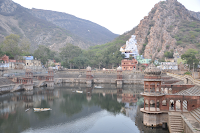 Last weekend, me and my wife Aditi, were at Alwar. On Saturday afternoon, we dropped in at the City Palace (now the home of Collectorate, Court and other Govt offices) to meet the District Magistrate o
Last weekend, me and my wife Aditi, were at Alwar. On Saturday afternoon, we dropped in at the City Palace (now the home of Collectorate, Court and other Govt offices) to meet the District Magistrate o f Alwar, Ashutosh Pedankar. Ashutosh wasn’t in, so w
f Alwar, Ashutosh Pedankar. Ashutosh wasn’t in, so w e decided to visit the Moosi Maharani Ki Chhatri, the imposing and exquisitely carved monument adjoining the erstwhile palace.
e decided to visit the Moosi Maharani Ki Chhatri, the imposing and exquisitely carved monument adjoining the erstwhile palace.Located in the foothills of Aravali Range, the Moosi Maharani ki Chhatri is one of the most famous cenotaphs in Alwar. Vinay Singh built the structure in honour of the Maharaja Bakhtawar Singh and his queen Rani Moosi in 1815. The chhatri has unusual Bengali roof and arches. To gain the access to the cenotaph, we took the steps on the far left when facing the palace.
The cenotaph is built on a pillared red stone. It is a double-storeyed structure. The upper storey boasts a magnificent architecture of marble. The interiors of the structure are equally attractive as they boast in
 tricate carvings. There is also a huge water tank, called Sagar, located opposite to the chhatri.
tricate carvings. There is also a huge water tank, called Sagar, located opposite to the chhatri.This artificial tank lined by a beautifully symmetrical chain of ghats with four pavilions on each side and two at each end, was built in 1815 A.D. by Maharaja Vinay Singh with few temples along its banks.
It was 6.00 pm and the light was fast fading. After seeing the Chhatri, we decided to go around the square tank before leaving the place. As we stepped down to the level of side alcoves, we saw at the left a huge barasinga deer sitting on an alcove. Clearly it was a stray deer t
 hat came from the hills at the back. It appeared fearless and composed, giving the required natural touch to the nearly 200-year-old monuments around. It seemed oblivious of the stray tourists, government babus leaving for home at the distance, children playing Cricket at the nearby ground, and honking of motorbikes and buses. Much like this old city that remained steeped in traditions and customs, despite the onslaught of the modern era.
hat came from the hills at the back. It appeared fearless and composed, giving the required natural touch to the nearly 200-year-old monuments around. It seemed oblivious of the stray tourists, government babus leaving for home at the distance, children playing Cricket at the nearby ground, and honking of motorbikes and buses. Much like this old city that remained steeped in traditions and customs, despite the onslaught of the modern era.
No comments:
Post a Comment